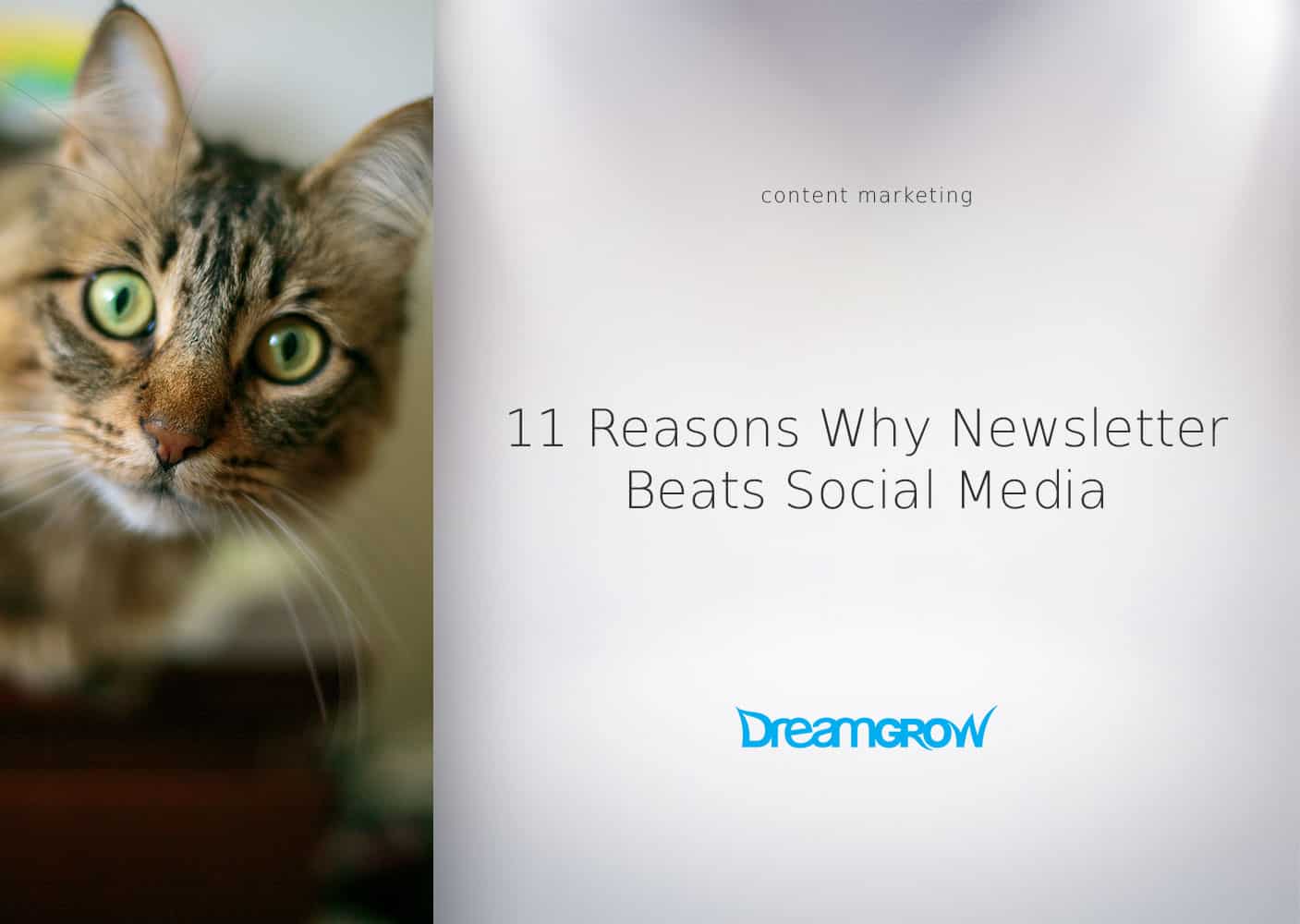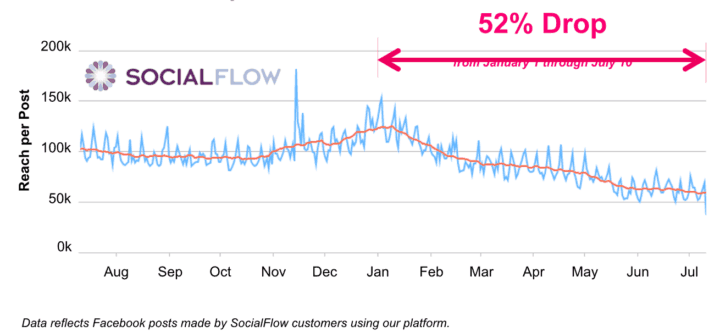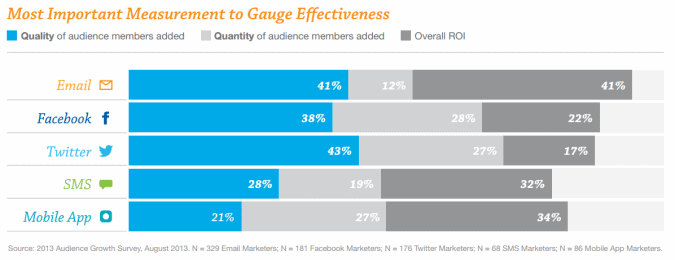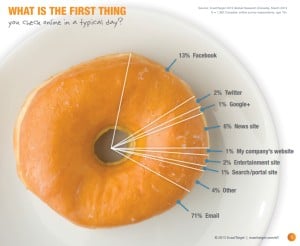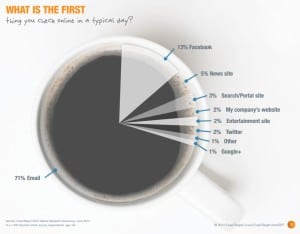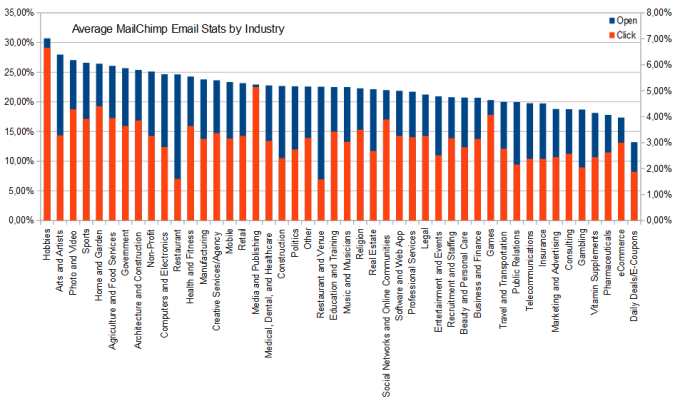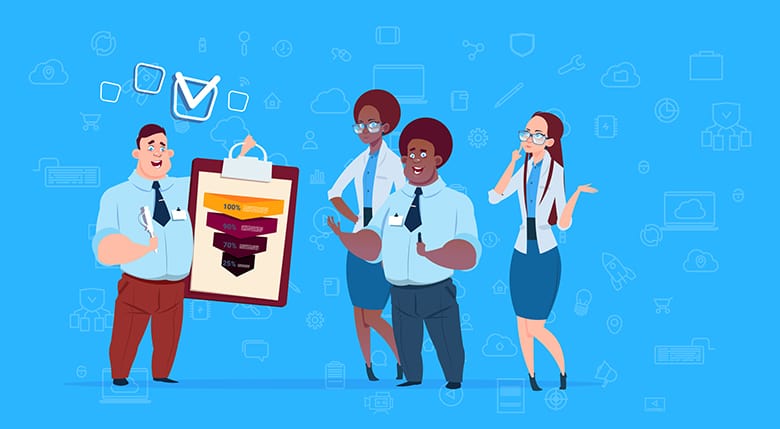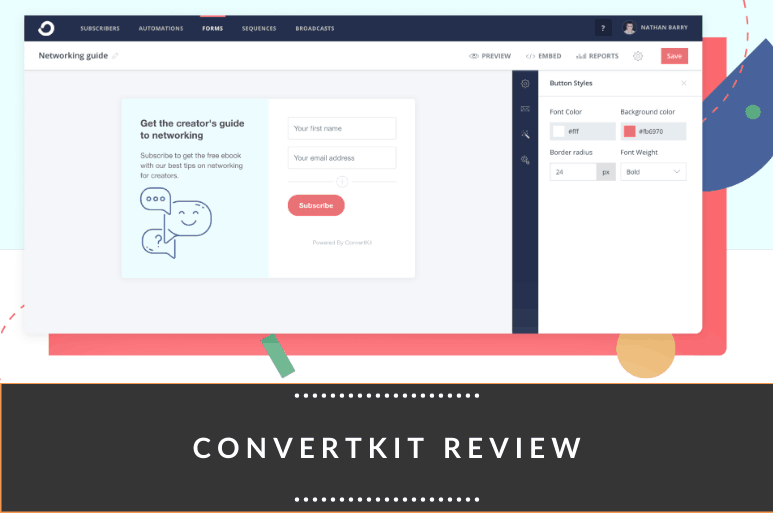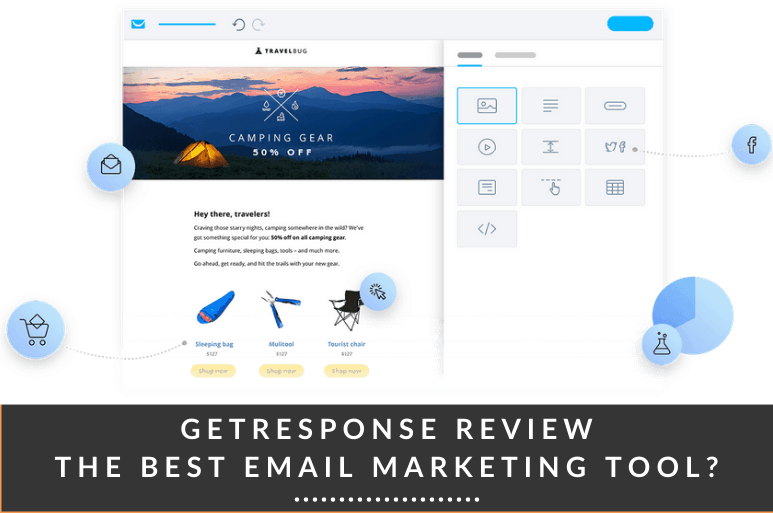Constant changes to what gets into the Facebook's newsfeed decrease organic reach. It’s clear that engaging your hard-won fans has become increasingly difficult.
In this post, I will cover the how and why email lists will work better for your marketing than social channels.
It’s time to reallocate some of your funds to your content marketing and list building.
Start integrating social media to boost your email marketing.
On January 12, 2018, Mark Zuckerberg announced the coming changes, outlining that they aim to ensure that the time people spend on Facebook is ‘well spent.’
Facebook repeated this message later in this video:
Person-to-person will be more valuable than person-to-Page. Connections with people in your network will get the biggest boost because interacting with people you’re close to is more meaningful
Facebook organic reach started to plummet around the end of 2013. An analysis published by Marshall Manson from Social@Ogilvy found that organic reach brands get for their posts on Facebook has crashed. Without putting money behind the posts' engagement has dropped almost 50% in the last 6 months. They conclude that:
Organic reach of the content brands publish in Facebook is destined to hit zero. It’s only a matter of time. –- Marshall Manson, Social@Ogilvy
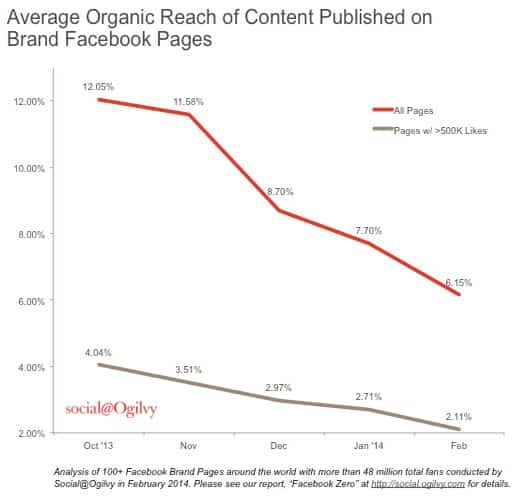
This does not mean that all social channels are tanking.
But it should make you cautious about where to invest your marketing dollars. The first step would be to start moving social media followers to your newsletter. Rethinking your email marketing strategy will give you better control over your marketing assets.
Most recent data from SocialFlow shows that the Facebook organic reach is continuing to go down. The reason behind this is an ever-increasing number of Facebook users create more and more content that competes for your newsfeed.
Facebook reached 2.2 billion users in March 2018. And there's the need for Facebook to sell ads.
Email is a more effective sales and communications channel than social networking sites.
Even if you are very active in managing your Facebook page or Twitter the potential return is much lower than using opt-in email lists. Social media channels are great for outreach. Next step would be to bring the people you reach there to your email list.
Email is the first step towards building a customer relationship database. It will help you nurture the leads, get the sale and create repeat business.
Email is at least 4 times more effective in reaching your audience than Facebook
- Email 20% open rate
- Facebook 5% talking about this
- 20,000 fans 1,000 > talking about this
- 5,000 emails 1,000 opened and 300 to 400 clicks to your site
Beyond that, there are plenty of strategies to improve your open rates.
Move from social media to email list to get more leads and conversions
Email is like a phone book of your friends, but social media is more like a casual acquaintance. Mailing lists give you more control over your communications. However this does not mean you should stop using social channels. Use social media as a constant source of new subscribers to your opt-in mailing list.
In 2016 every dollar spent on email is projected to bring in $35.02 –US Direct Marketing Association
1. You get more attention

With recent changes by Facebook the people who actually see your posts in their newsfeed has dropped dramatically. Now you have to use promoted posts to have any meaningful reach.
In the case of email, it’s a bit different. Even if it doesn't seem so, people have less mail than there are tweets and status updates in their newsfeed. So if you have managed to get them to sign up for your mailing list, you have less competing messages.
The other aspect of email is that people have to do something with the email, even if that is just clicking delete.
2. Control who sees what
You have full control over the content and design of your email.
Email tends to be technically more versatile. You can put more information in the email without making the user experience too painful. In the case of social media sites, you are stuck with the limited capabilities of the platform you are using.
3. Personalize for better results
Email is more personal than a message from the brand page on Facebook or tweet on Twitter. You can personalize messages in an email a lot more easily than on social media channels. In social media, personal customization may lead to one on one communication that will not scale. (Unless you hire an army of monkeys).
When I see a post from a brand in my Facebook newsfeed, I feel that I am watching a broadcast.
If you put in some effort, you can make the emails feel personal. But in the case of Facebook's wall posts, you simply can’t.
You either talk to one person, or you address everybody in more general terms. More personal touch is why people feel that when they get an email, it is meant just for them.
4. Segment messages to increase conversion
Right after personalization comes segmenting. Email is better at that!
You can slice and dice your mailing list any way you want. You have more information about subscriber’s earlier actions. Information about what emails they open and what links they click enables you to use that behavior to segment subscribers automatically.
Using Facebook will give you some control in the form of demographic targeting, but it’s hard to track that to the individual level. In the case of Twitter, you are flying blind.
Here is a useful integration option. Match the people from the social networks to the entries in your mailing list. Then you may able to add demographic information from Facebook to email database and take a step closer to the social CRM.
I will show you how to do this in the following chapters.
Find out how to use social media channels to build your newsletter.
5. Test what works
A/B and multivariate testing are one of the most important tools in any marketer's arsenal. Mailing lists are an exceptional channel to use for testing.
Email excels at the possibilities of testing content variations, segmentation, personalization, etc. From subjects to CTAs (call to action) and copy length versus image use, email is really flexible.
Email gives you another segmenting option not available in social media channels. Targeting recipients based on their earlier interactions:
- Did they open the email?
- Did they click any links?
- What specific link did they click?
There’s a lot of possibilities that show the engagement level of the subscriber but are not available in social media channels.
Facebook allows for demographic targeting. Demographic targeting is not possible if your list only consists of email addresses without extra data.
With the possibility of publishing an invisible post (hidden from newsfeed), Facebook is taking steps towards allowing to test different messages on different audiences. But the flexibility of Facebook options is far from that of email.
As segmenting becomes more important social networking sites might start to give marketers the tools that allow them to access that data. They already have that information, but it's not available to the mere mortals like us.
6. Legal questions are simpler
There are a lot of restrictions on the content that you can use on social networking sites. Guns, porn, gambling, prescription drugs, etc. In most cases, you are banned from social networking sites if you deal in any of those areas.
In the case of social networks you have three masters to consider:
- First, there are rules set by the social media site that may get you banned even if you think you are acting within the rules.
- Second, as the content on the social sites is usually publicly accessible to many more people than the intended audience then, the law might prevent you to post certain information. A good example of this is prescription drugs.
- And finally, what would others think argument? If you run a site with questionable content and operate within the rules of the social site and the law of the country, you still have to deal with the opinions of the wider audience, and your client base might not want to be associated with your business in any public way.
In the case of the email, the rules are a lot less strict. The law dictates what you can do.
When a person initiates a conversation with the business, then business can answer in great detail without getting in trouble with the law.
There’s no third party to set up additional rules. Email is also considered private enough that people are willing to subscribe to lists that they necessarily wouldn’t admit to in public.
These topics that people want to hide from others don’t have to be porn or gambling.
There are things like bad breath, skin conditions, baldness, plastic surgery, legal advice, etc.
7. Familiar channel will work in your favor
The best part?
People are familiar with commercial email.
Getting an email that contains business information and special offers is something that happens all the time, and people are accustomed to this.
In the email, you can include one part of commercial offers and add some useful content to that. This will make your communication less about hard selling and more about delivering value.
In the case of social media sites it’s not totally clear how much sales is acceptable.
One piece of social media content (a wall post, tweet, image, etc.) is usually about one thing. It’s a sales message or something else. If a person gets too many sales messages in a row they might want to opt out.
8. Email is still most used channel
Look:
Email is still the most used electronic media. Most people check it first thing in the morning and take a glance before they go to bed.
71% consumers favor email as their first online “check” of the day. –ExactTarget
9. You own your email list
Having a email list is like having a gold bullion under your mattress. It’s yours.
You have direct route to the people and you can use that whenever you feel like it. It is important that you know what you are doing but it is under your control.
In the case of third party sites like Facebook and Twitter, you are at the mercy of their decisions.
You have a Facebook app? Facebook changes its width.
You have thousands of likes? To reach them pay up!
Facebook has to find ways to justify its sky-high valuation. Twitter has made changes to how you can use its API to access the data that you have created. You can’t be sure that you have free access your followers in the future.
10. Email gets you more engagement
Value of the Facebook fan and Twitter follower is much lower than that of an email subscriber in your opt-in list. If you are doing it right then, you should get at least 20% of open rate.
Click through rates maybe 2-4% of or even higher. For some, these number may seem too low. That's because they are Average Email Campaign Stats of MailChimp Customers by Industry. You should aim higher.
In the case of Facebook, we can measure the engagement rate in the form of people “talking about this.” If you are not running a campaign or posting something really viral, your engagement rate tends to be in 2-6 percent range.
This means that email will engage several times more people than your social media channel. You should interact with your followers in social channels and encourage them to sign up for the email list.
For example: Let's take an email opt-in list of 10,000 subscribers and pit it against the Facebook page with 10,000 likes.
I would put my money on the email list to get the most customer engagement (and eventually sales). Twitter account with 10k followers would probably be the least effective of the three. Here's how to get the most out of your newsletter subscribers.
11. People prefer email for promotional messages
Besides getting more engagement, people consider email as the main commercial channel.
An ExactTarget study from 2012 found that more than three-quarters (77%) of people surveyed responded that email is the preferred channel for permission-based promotional messages.
Only 4% of respondents said that about Facebook and for Twitter it was measly 1%
Bottom line?
Integrating social media with newsletter and email marketing
I started with the idea that email lists are more effective than social media to deliver business results. Opponents have said it’s like comparing apples to oranges. This is true in a way.
Different marketing tools vary in effectiveness, but the most important metric for any marketing effort is ROI. You do marketing because you want to sell your products and services. The goal is to move the potential customer in the direction of making a transaction. That vehicle is email more often than not.
Ready to take your eCommerce store to the next level? Click here to read our review on the best eCom tool.
_________________________
Cat image Flickr
Header cat image Flickr
